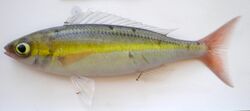Biology:Pentapodus
| Pentapodus | |
|---|---|

| |
| Pentapodus aureofasciatus | |
| Scientific classification | |
| Domain: | Eukaryota |
| Kingdom: | Animalia |
| Phylum: | Chordata |
| Class: | Actinopterygii |
| Order: | Spariformes |
| Family: | Nemipteridae |
| Genus: | Pentapodus Quoy & Gaimard, 1824 |
| Type species | |
| Pentapodus vitta Quoy & Gaimard, 1824
| |
| Synonyms[1] | |
| |
Pentapodus is a genus of marine ray-finned fishes belonging to the family Nemipteridae, the threadfin breams. These fishes are found in the Indo-Pacific region.
Taxonomy
Pentapodus was first proposed as a monospecific genus in 1824 by the French naturalists Jean René Constant Quoy and Joseph Paul Gaimard[1] when they described Pentapodus vitta from Shark Bay in Western Australia.[2] The 5th edition of Fishes of the World classifies the genus Pentapodus within the family Nemipteridae which it places in the order Spariformes.[3]
Etymology
Pentapodus is a combination of penta,meaning "five", and podus, which means "foot", what this was alluding to was not explained by Quoy and Gaimard. However, according to Valenciennes, who called the genus “Pentapus” in 1835, it was a reference to the three long, pointed scales, one above root of each of the pelvic and pectoral fins with a single one between these, giving the appearance of five ventral fins.[4]
Species
Pentapodus contains the following recognised species:[5]
- Pentapodus aureofasciatus B. C. Russell, 2001 (yellowstripe threadfin bream)
- Pentapodus berryae G. R. Allen, Erdmann & Brooks, 2018 (Deep reef whiptail)
- Pentapodus bifasciatus (Bleeker, 1848) (white-shouldered whiptail)
- Pentapodus caninus (G. Cuvier, 1830) (small-toothed whiptail)
- Pentapodus emeryii (J. Richardson, 1843) (double whiptail)
- Pentapodus komodoensis G. R. Allen & Erdmann, 2012 (Komodo whiptail)
- Pentapodus nagasakiensis (S. Tanaka (I), 1915) (Japanese whiptail)
- Pentapodus numberii G. R. Allen & Erdmann, 2009 (Papuan whiptail)
- Pentapodus paradiseus (Günther, 1859) (paradise whiptail)
- Pentapodus porosus (Valenciennes, 1830) (Northwest Australian whiptail)
- Pentapodus setosus (Valenciennes, 1830) (butterfly whiptail)
- Pentapodus trivittatus (Bloch, 1791) (three-striped whiptail)
- Pentapodus vitta Quoy & Gaimard, 1824 (striped whiptail)
Characteristics
Pentapodus fishes are separated from the other genera of Nemipteridae by the following characteristics. The body has a depth which fits into its standard length 3 to 3.5 times. The suborbital may be either scaly or naked with either having a weak spine or no spine. The rear margin of suborbital smooth, or has very small serrations and may have a small number of small denticulations. The rear edge of the preoperculum may have very small denticle or be smooth. The scales on the crown extend forward to or in beyond the centre of the eyes. The temples are scaly. There are 2 or 3 pairs of small canine-like teeth in the front of the upper jaw and a pair of larger, flared canine-like teeth on both sides of the lower jaw. The second spine in the anal fin is shorter and weaker than third spine.[6] The smallest species is P. kmodoensis with a maximum published standard length of 10.4 cm (4.1 in) while the largest is P. emeryii which has a maximum published total length of 35 cm (14 in).[5]
Distribution
Pentapodus fishes are found un the eastern Indian Ocean and western Pacific Ocean.[5]
References
- ↑ 1.0 1.1 Eschmeyer, William N.; Fricke, Ron; van der Laan, Richard, eds. "Genera in the family Nemipteridae". California Academy of Sciences. http://researcharchive.calacademy.org/research/ichthyology/catalog/fishcatget.asp?tbl=genus&family=Nemipteridae.
- ↑ Eschmeyer, William N.; Fricke, Ron; van der Laan, Richard, eds. "Species in the genus Pentapodus". California Academy of Sciences. http://researcharchive.calacademy.org/research/ichthyology/catalog/fishcatget.asp?tbl=species&genus=Pentapodus.
- ↑ Nelson, J.S.; Grande, T.C.; Wilson, M.V.H. (2016). Fishes of the World (5th ed.). Hoboken, NJ: John Wiley & Sons. pp. 502-506. doi:10.1002/9781119174844. ISBN 978-1-118-34233-6. OCLC 951899884.
- ↑ "Order SPARIFORMES: Families LETHRINIDAE, NEMIPTERIDAE and SPARIDAE". The ETYFish Project Fish Name Etymology Database. Christopher Scharpf. 17 October 2022. https://etyfish.org/spariformes/.
- ↑ 5.0 5.1 5.2 Froese, Rainer and Pauly, Daniel, eds. (2023). Species of Pentapodus in FishBase. October 2023 version.
- ↑ B. C. Russell (2001). "Nemipteridae". The Living Marine Resources of the Western Central Pacific Volume 5: Bony fishes part 3 (Menidae to Pomacentridae). FAO Species Identification Guide for Fishery Purposes. FAO Rome. p. 3051. https://www.fao.org/3/y0770e/y0770e28.pdf.
Wikidata ☰ Q1974305 entry
 |

